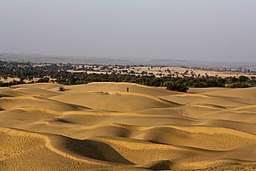Thar Desert
| The Thar desert | |
| Desert | |
|
Thar Desert Rajasthan, India
|
|
| Country | India and Pakistan |
|---|---|
| State | India: Rajasthan Haryana Punjab Gujarat Pakistan: Sindh Punjab |
| Biome | Desert |
| Plant | cactus |
| Animal | camel |
The Thar Desert, also known as the Great Indian Desert, is a large, arid region in the northwestern part of the Indian subcontinent that forms a natural boundary between India and Pakistan. It is the world's 17th largest desert, and the world's 9th largest subtropical desert. About 85% of the Thar Desert is in India, and the remaining part in Pakistan. In India, it covers about 320,000 km2 (120,000 sq mi), of which 90% is in Rajasthan and extends into Gujarat, Punjab, and Haryana. This desert comprises a very dry part, the Marusthali region in the west, and a semidesert region in the east with fewer sand dunes and slightly more precipitation.
The Thar Desert extends between the Aravalli Hills in the north-east, the Great Rann of Kutch along the coast and the alluvial plains of the Indus River in the west and north-west. Most of the desert is covered by huge shifting sand dunes that receive sediments from the alluvial plains and the coast. The sand is highly mobile due to strong winds occurring before the onset of the monsoon. The Luni River is the only river integrated into the desert. Rainfall is limited to 100–500 mm (3.9–19.7 in) per year, mostly falling from July to September.
Salt water lakes in the Thar Desert include the Sambhar, Kuchaman, Didwana in Rajasthan and Kharaghoda in Gujarat. These lakes receive rain water during monsoon and evaporate during the dry season. The salt is derived by the weathering of rocks in the region.
Lithic tools belonging to the prehistoric Aterian culture of the Maghreb have been discovered in Middle Paleolithic deposits in the Thar Desert.
...
Wikipedia

